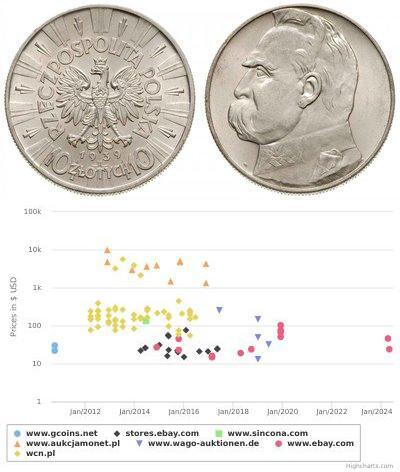5 Reichsmark (sold for $361.0)
1930, Germany (Weimar Republic). Large Silver 5 Mark "Rhineland Liberation" Coin. PCGS MS-65!
Mint Year: 1930 Reference: KM-71. Mint Place: Munich (D) Condition: Certified and graded by PCGS as MS-65! Denomination: Proof 3 Mark - Liberation of the Rhineland. Diameter: 37mm Material: Silver Weight: 25gm
Obverse: Eagle left on bridg. Date (19-30) divided on bridge. Legend: DER RHEIN DEUTSCHLANDS STROM . NICHT DEUTSCHLANDS GRENZE . Translated: "The Rhine, Germany´s River, not Germany´s Border" Reverse: Shield with German heraldic eagle on trefoil. Mint initial (D) above. Legend: DEUTSCHES . REICH (oak-leaf) FUNF . REICHSMARK (oak-leaf)
Historically, the Rhinelands refers (physically speaking) to a loosely-defined region embracing the land on either bank of the River Rhine in central Europe. More recently the Rhineland (Rheinland in German) has become the general name for areas of Germany along the middle and lower Rhine in Germany between Bingen and the Dutch border, or between the confluence with the Neckar and Cologne. To the west the area stretches to the borders with Luxembourg, Belgium and the Netherlands; on the eastern side it only encompasses the towns and cities along the river. Except for the Saar this area more or less corresponds with the modern use of the term.
It is a contentious issue but between the two world wars the term "Rhineland" covered the whole occupied and de-militarized zone to the west of the Rhine including the bridge-heads on the eastern banks (see map below). After the collapse of the French dominated West Bank in the early 19th century, the German and Dutch (Province of Jülich-Cleves-Berg) speaking regions at the middle and lower course of the Rhine were annexed to the kingdom of Prussia. The Prussian administration reorganized the territory as the Rhine Province (also known as Rhenish Prussia), a term continuing in the names of the German states of Rhineland-Palatinate and North Rhine-Westphalia. Following the First World War of the early 20th century, the western part of Rhineland was occupied by Entente forces, then demilitarized under the Treaty of Versailles. German forces remilitarized the territory in 1936, as part of a diplomatic test of will, three years before the outbreak of the Second World War.
The southern and eastern parts are mainly hill country (Westerwald, Hunsrück, Taunus and Eifel), cut by river valleys, principally the Rhine and Mosel. The north takes in the Ruhr valley.
Some of the larger cities in the Rhineland include Aachen, Bonn, Cologne, Duisburg, Düsseldorf, Koblenz, Krefeld, Leverkusen, Trier.
Only 1$ shipping for each additional coin purchased!

|
Posted by:
anonymous 2018-11-19 |
|
||
|
||
|
||

-600-300-uiU32loY_68AAAFnXlEWgiqO.jpg)

-300-150-F1YKbzbiQ80AAAFPI7KA8IYV.jpg)
 English
English













